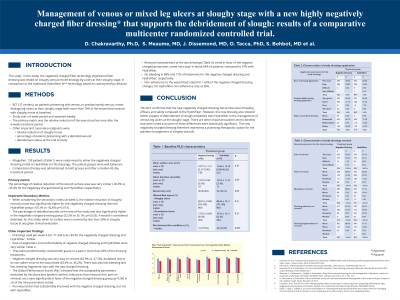Clinical Research
(CR-010) Management of venous or mixed leg ulcers at sloughy stage with a new charged fiber dressing that supports the debridement of slough: results of a comparative multicenter randomised controlled trial.

The objective of this study was to compare the efficacy, safety and acceptability of a charged fiber dressing versus an established caboxymethylcellulose (CMC) based dressing in the leg ulcer treatment at the necrotic/sloughy stage.
Methods:
A non-inferiority RCT was conducted on patients with venous or predominantly venous mixed leg ulcers. The Primary judgment criterion was the relative regression of the wound surface area after 6 weeks of treatment. Secondary endpoints were the relative reduction of sloughy tissue with adherent debris, the percentage of patients with a clean wound after 6 weeks.
Results:
159 patients were randomized to either the charged fiber or a carboxymethylcellulose based dressing group. At baseline, the two groups were comparable. After 6 weeks, percentage of relative regression of the wound surface area were similar into the two groups (-34,1% vs -34,4% in the charged fiber dressing and carboxymethylcellulose groups respectively). The relative reduction of sloughy tissue is significantly better in the charged fiber dressing group than in carboxymethylcellulose group (-65,3% vs -42,6%; p=0.013). The percentage of cleansed wounds is significantly better for the charged fiber dressing group (52,5% vs 35,1% ; p=0.033). The safety was very similar in the two groups, and both were well tolerated.
Discussion:
The randomized controlled trial showed that the charged fiber dressing has similar efficacy and safety compared to an established carboxymethylcellulose dressing. However, the charged fiber dressing shows better properties to support the debridement of slough during the management of exudate in leg ulcer treatment at sloughy stage with visible presence of adherent debris.

.jpeg)